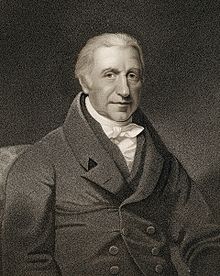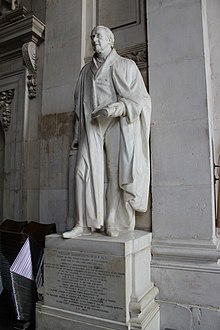William Babington (physician)

William BabingtonFRSFGS(21 May 1756 – 29 April 1833) was anAnglo-Irishphysicianandmineralogist.
Life and work[edit]
William Babington was born inPortglenone,near Coleraine, Antrim,Ireland.He was the son of Rev. HumphreyBabington,the great-great-grandson ofBrutus Babington(sent to Ireland byJames VI and I),[1]and his wife Anne (née Buttle). Apprenticed to a practitioner at Londonderry, and afterwards completed his medical education at Guy's Hospital, London, but without at that time taking a medical degree. In 1777 he was made assistant surgeon to Haslar (Naval) Hospital, and held this appointment for four years. He then obtained the position of apothecary to Guy's Hospital, and also lectured on chemistry in the medical school. He resigned the post of apothecary, and, having obtained the necessary degree of MD from theUniversity of Aberdeenin 1795.[2]in 1796 he joinedDr William SaundersatGuy's HospitalinLondonas his assistant and in 1802/3 (at Saunder's recommendation) replaced Saunders as head Physician.[3]

Babington was physician toGuy's Hospitalfrom 1795 to 1811. He was a founder member of theGeological Society of Londonand served aspresidentfrom 1822 to 1824. He was elected as aFellow of the Royal Societyin 1805.
He was the curator for the enormous mineral collection ofJohn Stuart, 3rd Earl of Bute.When Bute died in 1792, Babington bought the collection. The mineralBabingtoniteis named after him.
William and Martha Elizabeth Babington were married before 1794, and had four sons and four daughters between 1794 and 1810. Babington died on 29 April 1833 and was buried atSt. Mary Aldermanburyin London.[4]He left a son,Benjamin Guy Babington,[5]also physician to Guy's Hospital, and a daughter, Martha, who married the physicianRichard Bright.[6]
A statue of Babington byWilliam Behnes(1795–1864) is inSt Paul's Cathedralin London.[7]
Anthony Babington,theIrishpolitician was a direct descendant.
Selected publications[edit]
- "A Systematic Arrangement of Minerals, founded on the joint consideration of their chemical, physical and external characters; reduced to the form of tables." (1796) London, T. Cox.
- "A New System of Mineralogy, in the form of a Catalogue, after the manner of Baron Born’s Systematic Catalogue of the collection of fossils of Mlle Éléonore de Raab".(1799) London, T. Bensley. (Referring toIgnaz von Born's catalogue of the collection of Austrian collector Éléonore de Raab[8])
Further reading[edit]
- Munk, William(1878).The Roll of the Royal College of Physicians of London.London: Royal College of Physicians. pp.451–455.Retrieved11 March2008.
- Smyth, George Lewis (1843).Biographical Illustrations of St. Paul's Cathedral.London: Whittaker and Company. pp. 93–94.Retrieved11 March2008.
References[edit]
- ^Burke's Landed Gentry of Irelandby Bernard Burke[full citation needed]
- ^A biography on William Babington,‘Babington, William (1756–1833)’,sourced from the college archives in King's College London.
- ^The European Magazine and London Review vol 72 (1817) p.295
- ^Munk, William(1878).The Roll of the Royal College of Physicians of London.London: Royal College of Physicians. pp. 451–455.
- ^Bevan, Michael. "Babington, Benjamin Guy (1794–1866)".Oxford Dictionary of National Biography(online ed.). Oxford University Press.doi:10.1093/ref:odnb/968.(Subscription orUK public library membershiprequired.)
- ^Thackray, John C. "Babington, William (1756–1833)".Oxford Dictionary of National Biography(online ed.). Oxford University Press.doi:10.1093/ref:odnb/977.(Subscription orUK public library membershiprequired.)
- ^"Memorials of St Paul's Cathedral"Sinclair, W.p. 472: London; Chapman & Hall, Ltd; 1909.
- ^Kahr, Bart (27 February 2022)."Gender and Library of Mineralogy".Crystals.12(3): 333.doi:10.3390/cryst12030333.
External links[edit]
- Webb, Alfred(1878)..A Compendium of Irish Biography.Dublin: M. H. Gill & son.
- Babingtonite
- King's College London Archive Holdings for Babington.
- 1756 births
- 1833 deaths
- Irish mineralogists
- 19th-century Irish medical doctors
- Fellows of the Royal Society
- Fellows of the Geological Society of London
- Presidents of the Geological Society of London
- 18th-century Anglo-Irish people
- 19th-century Anglo-Irish people
- Babington family
- Physicians of Guy's Hospital
- Medical doctors from County Antrim
- Scientists from County Antrim
